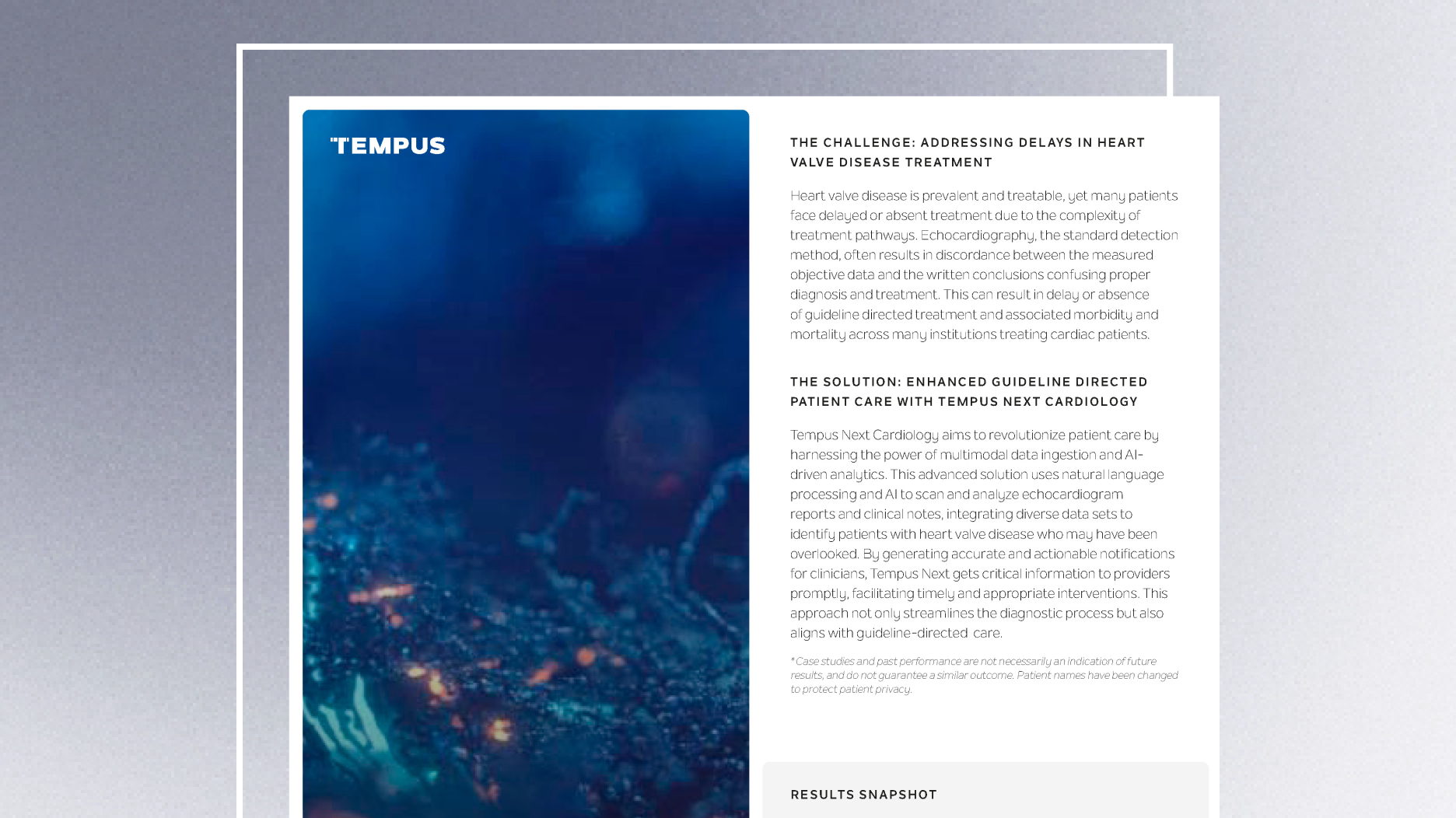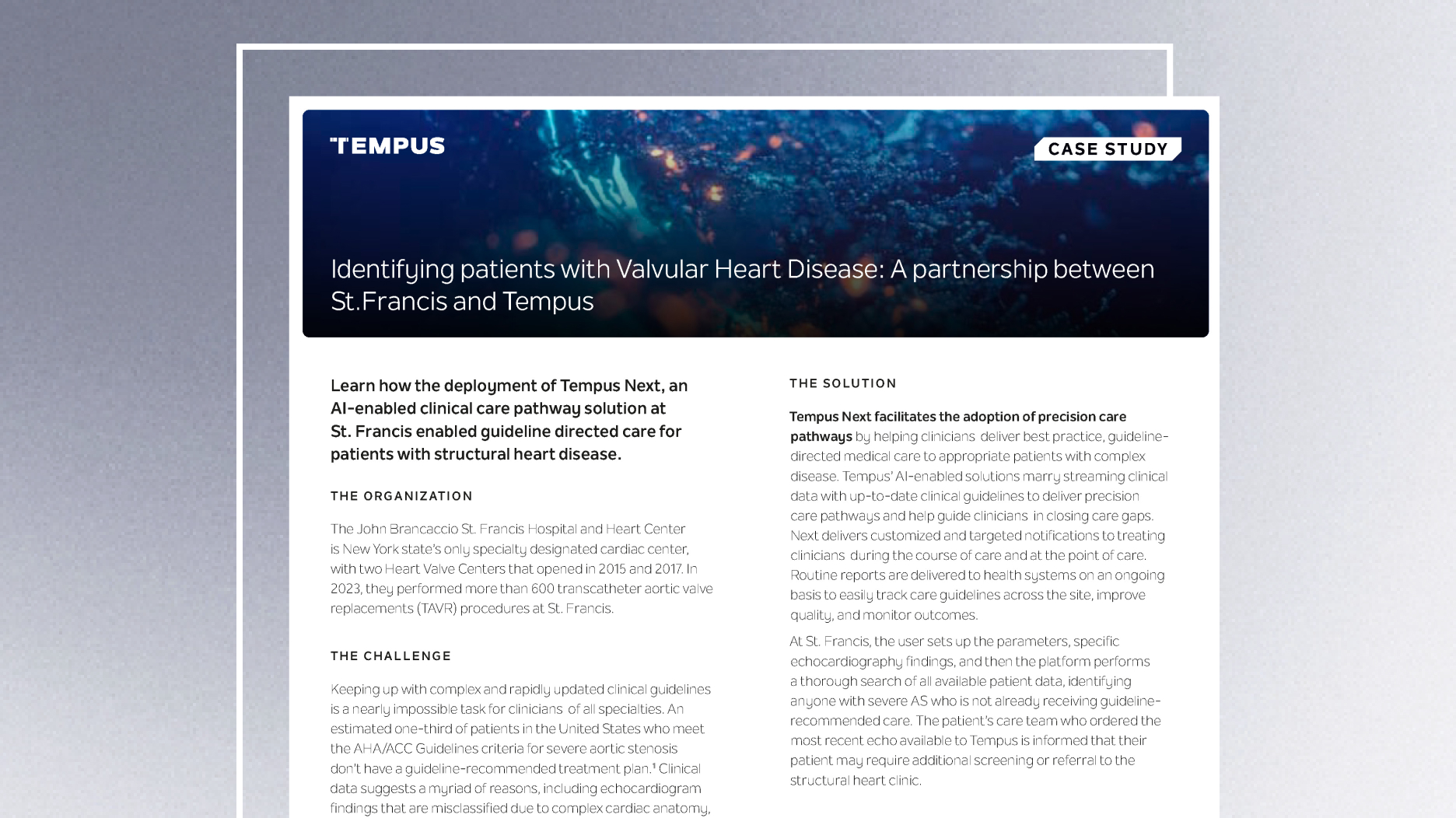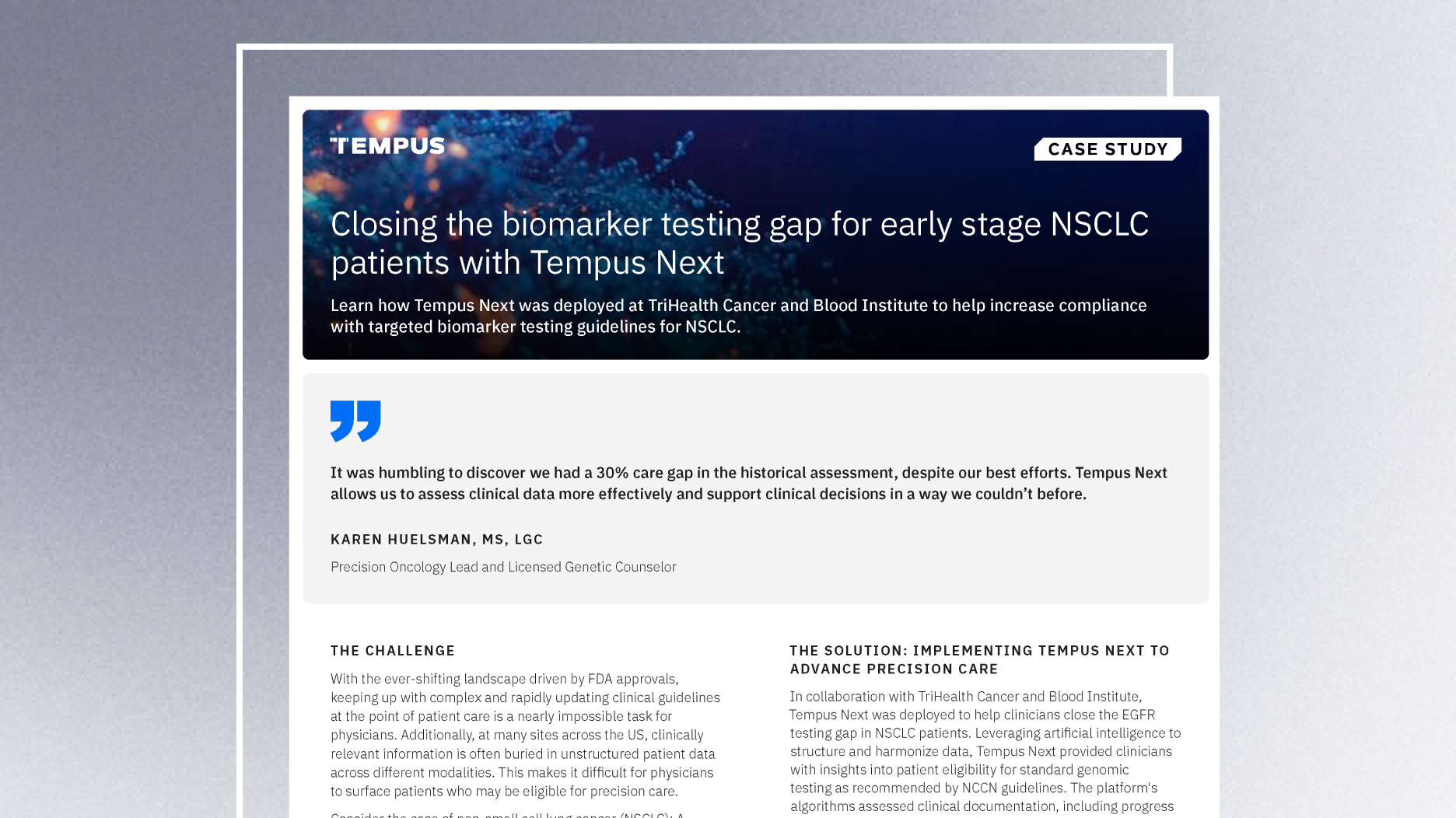-
PROVIDERS
Register now
Are you getting the full picture? A webinar series on the power of comprehensive intelligent diagnostics
-
LIFE SCIENCES
Enroll now
Tempus’ Patient-Derived Organoid ScreensEvaluate the efficacy of your preclinical compounds using fixed organoid panels designed for diverse therapeutic applications. Space is limited — enroll by June 30, 2025, to secure your spot.
-
PATIENTS
It's About Time
View the Tempus vision.
- RESOURCES
-
ABOUT US
View Job Postings
We’re looking for people who can change the world.
- INVESTORS
10/20/2023
Five key learnings from an evidence and guidelines-based application of PGx in mental health
Physicians discuss the role of pharmacogenomics in clinical practice.
Authors
Jon Durrani, MD
Practicing Neurologist, Dayton Center for Neurological Disorders

Muneer Ali, MD
Child, Adolescent and Adult Psychiatrist & Senior Director of Medical Affairs, Neuro/Psychiatry, Tempus

Practicing Neurologist, Dayton Center for Neurological Disorders

Muneer Ali, MD
Child, Adolescent and Adult Psychiatrist & Senior Director of Medical Affairs, Neuro/Psychiatry, Tempus

Providers treating patients with mental health conditions can utilize Tempus’ pharmacogenomics (PGx)-based mental health platform to inform personalized patient treatment. Guided by clinical evidence, PGx testing informs crucial treatment steps for these conditions, such as determining which medications to select, which doses are appropriate, or which side effects patients might experience.
In a recent webinar, two clinical practitioners—an adult and adolescent psychiatrist and a neurologist from the Dayton Center for Neurological Disorders—discussed how pharmacogenomics applications advance the treatment of mental health conditions.
Below, we share five key learnings from a webinar by Dr. Muneer Ali, Senior Director of Medical Affairs at Tempus, and Dr. Jon Durrani, a neurologist at Dayton Center for Neurological Disorders, about the significance of using an evidence and guidelines-based approach to PGx reporting for mental health treatment.
For their full discussion, watch the webinar here.
#1 Strong clinical evidence for the utility of PGx in treating mental health conditions
Pharmacogenomics (PGx) is a growing field that enables clinicians to study the influence of patient-specific genetic variation on clinical outcomes upon administering treatment. Whereas clinical providers typically prescribe medications based on physiological factors, such as age, weight, and organ function, PGx takes a precision medicine approach—allowing the providers to optimize patient treatment by incorporating genetic testing data.
Dr. Ali mentioned that Tempus’ long standing precision medicine expertise in oncology (evidenced by partnerships with over 6000 oncologists) translates to mental health, where over 3000 providers currently utilize the nP PGx test in clinical practice. There’s a dire need for fast, adaptive treatment options to care for the large population of over 52 million patients suffering from mental health conditions.
“With nearly 70% of patients failing their first and second antidepressant, and up to 30% never responding, categorized as having “treatment-resistant depression,” there is a strong need for PGx testing to address the gaps in current standards of mental health treatment,” Dr. Ali added.
The evidence for PGx as a robust tool for treating mental health conditions has grown substantially, evidenced by a 117% increase in publications related to PGx testing in psychiatry in recent years. Notably, a 2022 meta-analysis of over a dozen open-label and randomized clinical trials revealed that patients who received PGx-guided antidepressant therapy were nearly twice as likely to achieve remission, relative to those who received standard treatment.
#2 Guidance from the FDA and expert consortia enables accurate, evidence-based use of PGx reporting
Dr. Ali also emphasized that PGx reports can—and should—be based on guidelines from regulatory entities like the FDA, which already lists guidance for 250 medications with associated biomarkers that can help clinicians predict genetic predisposition for certain adverse events. And interestingly, neuropsychiatry is the second-largest clinical specialty with actionable biomarker associations, after oncology and hematology.
Additionally, guidance from the Clinical Pharmacogenetics Implementation Consortium (CPIC), an international group of PGx experts who collaboratively evaluate published research to provide peer-reviewed, evidence-based guidelines to support PGx applications, is crucial for genomics-driven neurology and psychiatry treatment.
Dr. Ali explained that CPIC constantly releases new guidance for PGx-based treatments following evaluation of the clinical relevance of the PGx applications. He highlighted that Tempus incorporated recently updated CPIC guidelines for selective serotonin reuptake inhibitors (SSRIs), the most commonly prescribed class of psychotropics, into its nP PGx report to ensure providers remain up-to-date with these critical guidelines.
By incorporating these FDA and CPIC guidelines into its nP PGx report, Tempus saves clinicians time while providing accurate, up-to-date clinical evidence to drive informed decision-making.
Considering the vast information available for clinicians to sift through when making clinical decisions, there’s simply not enough time to do so efficiently while providing robust care. However, in its PGx platform, Tempus provides transparent and evidence-based reports hyperlinked to reference information for over 100 medications related to various mental health conditions, keeping clinicians up-to-date with the latest clinical recommendations.
#3 Industry discrepancies in PGx reporting undermine the accuracy of patient treatment
Although PGx for neuropsychiatry has gained prominence in many clinical practices, some providers still base their treatment decisions on inaccurate guidelines that fall short of CPIC’s standards. “This impacts how patients are monitored and dosed for commonly prescribed medications,” Dr. Ali explained.
He referenced a 2022 University of Michigan study, which indicated that phenotypic assignment resulted in differences in medication recommendations that impacted nearly 50% of patients in the study. “Considering the frequency at which medications impacted by genotypes like CYP2D6 and CYP2C19 are prescribed, the consequences of inaccurate reporting has the potential to significantly impact patient care,” Dr. Ali emphasized.
Dr. Durrani, who has previously used other PGx platforms, highlighted the crucial role of Tempus’ CPIC-guided PGx platform in clinical practice using an example from a real case study of a patient treated for depression. He had a patient who was identified as a rapid metabolizer for CYP2C19, the gene responsible for metabolizing the medications in question, which were Celexa® and Lexapro®. Although the rapid metabolizer phenotype was flagged in Tempus’ platform, Dr. Durrani emphasized that the same corresponding CYP2C19 *1/*17 was the same genotype inaccurately classified as normal in the 2022 University of Michigan study.
In this specific scenario, Dr. Durrani found that early and accurate classification of the CYP2C19 *1/*17 rapid metabolizer phenotype enabled him to increase the dosing from the onset of treatment, eliminating any speculation that might have arisen when using a non-evidence-based test. He added that PGx helps clinicians to continuously consider the ramifications of gene-drug interactions, especially for patients suffering from other comorbidities.
#4 The Tempus nP PGx report is committed to following the latest FDA and expert consortia guidelines, and is a part of a holistic solution to provide personalized mental health care
Dr. Ali and Dr. Durrani discussed the key benefits of the Tempus PGx report in clinical practice. In Dr. Durrani’s clinical workflow, the Tempus PGx platform enables evidence-based decision-making supported by the latest FDA and CPIC guidance. Clicking the citations for each medication within the Tempus nP PGx report will link directly to the relevant FDA or CPIC guidelines that inform medication or dose selection.
For instance, the April 2023 CPIC updates provided the latest information regarding the metabolism of certain antidepressants based on their associated biomarkers, effectively guiding clinical decisions on dosing, efficacy, and tolerability. These CPIC updates are already incorporated into the Tempus nP report.
With guidance from the Tempus PGx platform, Dr. Durrani can also personalize treatment for his patients and bring precision mental health care closer to them. When used in combination with Tempus PGx reports, Dr. Durrani mentioned that TempusPRO™ —a mobile-based digital solution—enables the assignment of validated assessments to holistically and precisely understand each patient’s response to treatment between appointments. Tempus nP along with Tempus PRO™can work together to deliver personalized mental health care to patients.
#5 Best practices for incorporating PGx testing into clinical practice
Speaking practically, Dr. Ali and Dr. Durrani agreed on the value of basing clinical decision-making on objective, evidence-based data gained from PGx testing. Dr. Durrani believes doing so helps determine the risk of adverse events associated with certain medications, along with guiding dose optimization strategies for patients predicted to have lower- or higher-than-baseline responses to these medications. Dr. Ali added that he discusses with his patients about the role of PGx in informing prescription decision-making with consideration for side effects and dosage limitations.
When implementing PGx in a clinical workflow, Dr. Durrani typically sends a buccal swab PGx testing kit to a patient’s home and receives the testing results by each patient’s next appointment. Likewise, Dr. Ali follows a similar procedure when treating his patients, mailing them testing kits and having Tempus representatives address outstanding questions.
Although the Tempus PGx report provides data on emerging evidence genes, Dr. Durrani explained he doesn’t use it to guide first-line clinical decisions. Dr. Ali agreed, mentioning there’s limited or mixed evidence about some of the genomic data in this category and its relevance for clinical decision-making.
Looking forward, both clinicians believe pharmacogenomics is a robust complementary decision-making tool that will transform the pace of clinical care across mental health conditions, especially when applied upfront in the treatment process.
If you have questions about Tempus’ nP PGx testing or the Tempus PRO™ tool, please contact the Tempus team here.
-
06/25/2024
Revolutionizing Cardiac Care: AI-driven detection and treatment of critical heart valve disease at Boulder Community Health
Discover how Tempus Next's AI-powered care pathway platform transformed patient outcomes by helping ensure timely, guideline-directed treatment for critical heart valve disease at Boulder Community Health
Read more -
04/15/2024
Identifying patients with Valvular Heart Disease: A partnership between St.Francis and Tempus
Learn how the deployment of Tempus Next, an AI-enabled clinical care pathway solution at St. Francis enabled guideline directed care for patients with structural heart disease.
Read more -
04/15/2024
Closing the biomarker testing gap for early stage NSCLC patients with Tempus Next
Learn how Tempus Next was deployed at TriHealth Cancer and Blood Institute in Cincinnati, Ohio to surface and close gaps in biomarker testing for NSCLC patients.
Read more


